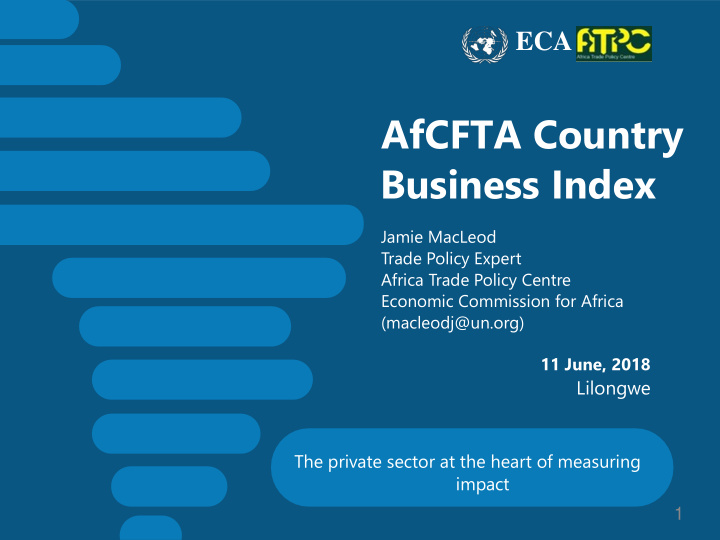



ECA AfCFTA Country Business Index Jamie MacLeod Trade Policy Expert Africa Trade Policy Centre Economic Commission for Africa (macleodj@un.org) 11 June, 2018 Lilongwe The private sector at the heart of measuring impact 1
ECA 1| Outline Background 2 The business case for continental integration • Businesses currently face average • Consolidate African market tariffs of 6.1% when they trade across • Highly dynamic market: the population of Africa. Africa is projected to reach 2.5 billion by 2050 • NTBs even bigger obstacle. • RVCs
ECA Receivables Motivating questions 3 ❖ How can we provide value for businesses looking to use the AfCFTA? ❖ How can we evaluate the AfCFTA ‘ on the ground ’ , as it actually affected businesses?
ECA Receivables Motivating questions 4 AfCFTA Country Business Index ❖ The index aggregates the opinions of businesses in Africa and articulates them in an index to ensure that the AfCFTA responds to their interests. ❖ It listens to the actual effect that the AfCFTA has on business, and challenges countries to respond to improve the trading environment. ❖ Star performing countries are recognized for their efforts, while laggards are identified and flagged.
ECA Part 1: Framing the tool VISION AND OBJECTIVES OF THE AFCFTA COUNTRY BUSINESS INDEX 5
ECA Receivables 6 1| Objectives of the M&E tool Vision • AfCFTA Country Business Index measures impact in a way that generates real value for the private sector operators that use the AfCFTA. Objectives • Measure implementation of the AfCFTA ‘on the ground’, as it actually affects businesses • Benchmark countries to reward those effectively implementing the AfCFTA, and flag laggards • Provide value to the full breadth of private sector operators, from MSMEs to large corporates • Evaluate the developmental impact of the AfCFTA, including gender dimensions and implications for vulnerable groups • Shine light onto ‘ knowledge gaps ’ by creating data where none previously existed
ECA Part 2: Putting it to work HOW IT WORKS 7
ECA Receivables 8 2| How it works • Views are collected from businesses : a survey is administered through regional and local chambers of commerce and industry allowing the collection of primary data for the index. • Complemented with data-based indicators : analysis of secondary data, including tariff schedules and volumes of trade. • These views and data are aggregated : into metrics across 4 dimensions: a) AfCFTA implementation b) Easing trade in Africa c) Trade for development d) AfCFTA Impact Chapter 6: CFTA Governance • Countries are ranked : by their score according to each dimension
ECA Receivables 9 3| Detail on dimensions DIMENSIONS OVERVIEW OF INDICATORS • Monitor implementation: ratification, goods MAO, services MAO, paper -> practice? AfCFTA • Is required documentation publically available? Are Implementation preferences accepted by customs? • Trade facilitating issues: • Easing trade Is trade finance available? Is border administration in Africa transparent? How long does it take to clear goods at ports/borders? • Developmental aspects of the AfCFTA: Trade for • Have you invested recently in export producted? Are you development employing more or less workers? Have you expanded into new products? • Measure aggregate AfCFTE effect: AfCFTA • Reduction in overall trade costs, improvements in non-tariff Chapter 6: CFTA Governance Impact barriers, increases in intra-African trade flows
ECA Receivables 10 3| Detail on dimensions DIMENSIONS OVERVIEW OF INDICATORS Questions to verify operation of AfCFTA on the ground: eg “do customs accept AfCFTA RoO AfCFTA certificates” Questions asking Implementation whether sufficient trade supports are in place Questionnaire answers from private sector (via Easing trade PACCI and regional and national chambers) in Africa Trade for Questions that measure development developmental impact: eg “workers employed in new trade to AfCFTA countries?” AfCFTA Chapter 6: CFTA Governance Impact Questions to measure improvements in NTBs, infrastructure, service restrictions
ECA Receivables 11 4| Closing questions Closing questions • Index is still in inception stage : want to hear from businesses... • What trade-related issues would you like put into metrics and articulated to policy makers? • What are the main challenges you face with other preference schemes (SADC/COMESA etc)? • What would success look like, how can we measure and report on this? Chapter 6: CFTA Governance
ECA THANK YOU!
Recommend
More recommend